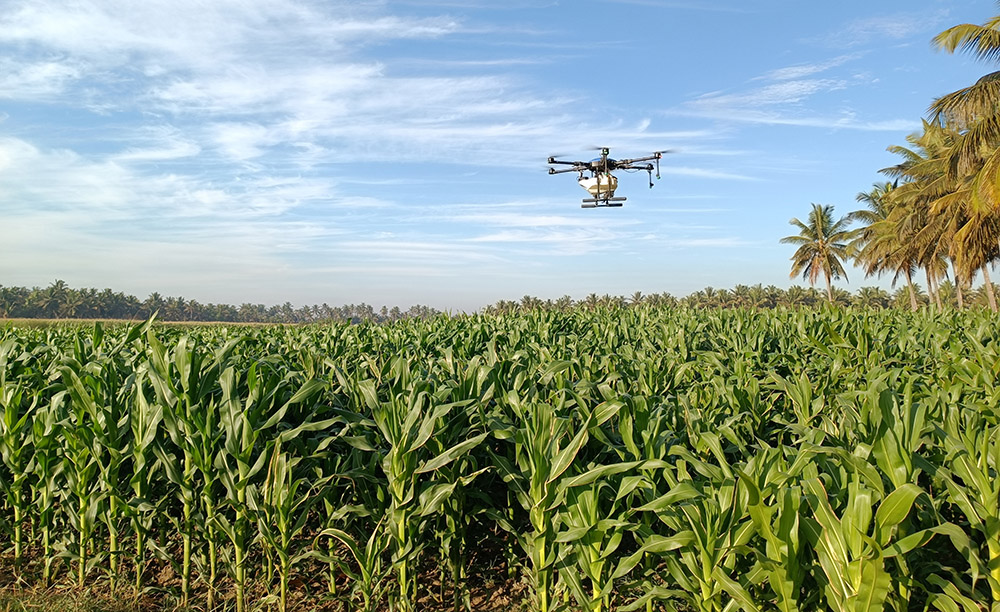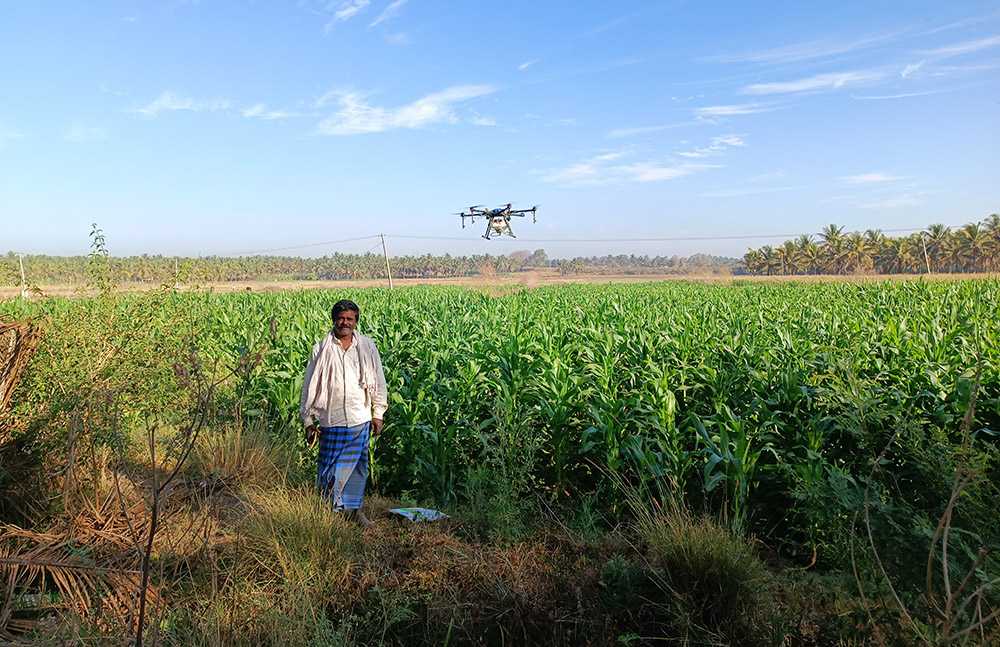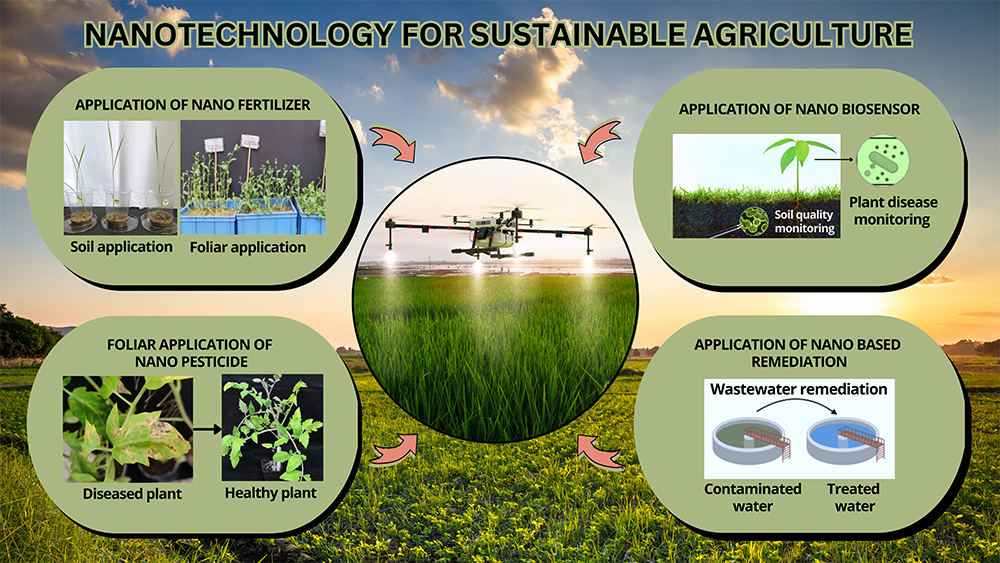
Its deceptively small size is no measure of its impact. Nanotechnology may work at a small scale, but the minuscule size of nanomaterials belies their efficiency. Little wonder then that the technology is being increasingly applied in agriculture to enhance efficacy and, importantly, to shrink the adverse impact of conventional chemical fertilizers on the environment and health.
The TERI-Deakin Nanobiotechnology Centre has been working to evolve ways of effectively using nanobiotechnology to provide sustainable agriculture solutions. In this ‘Q&A with TERI Expert,’ Dr Pushplata Singh, Senior Fellow at the Centre of Excellence in Agrinanotechnology, talks to Palak Khanna from the Communications Team about the incisive role the technology can play in the fields of agriculture and beyond. The use of nano-fertilizer, in combination with conventional fertilizer, can significantly reduce the application size of conventional fertilizers by 25-50% in agricultural fields. The utilization-efficiency of nano-fertilizer is generally between 90-95%, and even 100% occasionally, says Dr Singh. She also details the nano-products developed by TERI -- nano-fertilizers, nano-pesticides -- and why drones are the most effective way to apply nano-fertilizers on crops.
Read the edited excerpts from the interview.
What is nanotechnology and what is the principle on which it works?
Nanotechnology, as the name suggests, works at the nanoscale. The difference between a meter and a nanometer is 109. When the size of a material is reduced by such magnitude, there is a huge change at the surface-chemistry level, and the surface area-to-volume ratio increases significantly.
The material becomes highly reactive when there is a gain in surface area over the volume. There are two important impacts of it; they become highly reactive and when used as crop macro or micronutrients, it increases the fertilizer uptake efficiency in plants by several folds. The other aspect is that their frequency of interaction with all biological surfaces increases, which influences safety to human health and the environment.
What are the nanotechnologies developed by TERI to help farmers with climate-smart farming techniques?
In TERI, we develop nanomaterials using a biogenic approach. Microbial organisms are tuned as bio-factories for converting bulk material into nanomaterials, which generally make all nanomaterials produced by TERI safe by design for human health and the environment. We are developing nanomaterials primarily for use in agriculture in the form of nano-fertilizers, nano-pesticides, and smart carriers. At the commercial level, TERI aims to launch some of the nano-fertilizers in the second and the third quarter of the on-going fiscal year 2023-24, and it will include nano-urea, nano-di-ammonium phosphate, and nano-phosphorus. At the research level, TERI is working towards fertilizers including nano-NPK, nano-sulphur, nanocomposite of zinc and iron, nano-boron, multiple nano-micronutrients; nano-pesticides including nano-copper and nano-sulphur; and nano-2,4 D as a weedicide.
Besides agriculture, we are also developing nanomaterials for water treatment and for enhancing the fuel efficiency of non-conventional fuels like hydrogen. We can also enhance the properties of paints, such as increasing their anti-fouling properties and preventing bacterial and fungal growth, consequently help provide smooth and shiny surfaces which cannot be degraded by harsh environmental conditions using nanotechnology. TERI has been working towards developing paint-based nanomaterials based on zinc, and molybdenum nanoparticles derived from environmental waste materials.
"TERI is developing all the nanofertilizers by using a biological approach instead of a chemical approach"

Dr Pushplata Singh
How can nanotechnology be useful in agriculture and allied sectors? What are the potential benefits and drawbacks of this technology?
The use of nano-fertilizer will reduce the application size of fertilizer in agricultural fields. They are highly efficacious as compared to conventional fertilizers. Since the size of conventional fertilizers tend to be big, their uptake efficiency usually varies between 20%-40%, which means that depending on the soil type and agroclimatic zone, on the application of 100 kg of conventional fertilizer, a maximum of 40 kg gets used by the plant and, the remaining 60% gets washed off to different environmental pockets, contaminating the water table. However, with the use of nano-fertilizer, uptake by plant increases significantly and the quantity of fertilizer application gets reduced drastically.
In some cases, the utilization-efficiency of nano-fertilizer goes up to 95%, or even 100%. Additionally, small-sized nanomaterials also impart a quantum effect. In simple language, they act as additional reaction centers in plant leaves and help plants in increasing their photosynthetic rate. In effect, with nano-fertilizers, the utilization efficiency is high, and the application scale is very low. So instead of 50 kg, you may apply only a few grams, this way, application doses reduce by 100 to 200 times. Moreover, it reduces the burden on the farmer.
It also impacts the supply chain in a positive manner. For instance, at the agriculture ministry level, when 50 kg gets replaced by a few grams, the import and procurement of raw materials for fertilizers will also be proportionately reduced. The fuel required for transportation will also come down, for instead of 50 kg, you only need to spend the energy required for a few grams. Similarly, instead of 20 trucks going from a factory, probably one truck would be enough, or a smaller vehicle would do.
Farmers will incur the same cost as there would not be any subsidy on nano fertilizers as they are specialty fertilizers, and subsidies are only for regular fertilizers like conventional urea. What farmers would look for instead is a gain in crop yield over conventional fertilizers. We have witnessed a 15 to 20% gain in yield which ultimately results in increased incomes for farmers when compared to conventional fertilizers.
The use of nanotechnology transforms practice.
TERI is developing nano fertilizers using biological agents such as bacteria or fungus, so there are no hazardous chemicals used in the synthesis process of these nanomaterials. The synthesis process reduces the size of large solid fertilizer particles into small ones (nanometres), ensuring the same functional characteristics for each nanoparticle as compared to a conventional fertilizer particle. The methodology tends to be safe and green.

How is nanotechnology applied in agriculture?
When it comes to the application of nanotechnology-based agents, whether it is fertilizer or pesticides, drones are an easy way of application. India now has the required guidelines and policies for drone use in place. Drones would soon become available with local vendors in different cities and villages, and farmers can take them on loan or hire them for a few hours or weeks. All the nanotechnologies that TERI has developed performed well when supported by drones. The use efficiency, which is already at 95%, goes upto 100% when drones are used. In a nutshell, a drone is one mechanism to apply nanotechnology in agriculture. But small farmers with a landholding of about 2.5 hectares use manual sprayers with the normal nozzle setups, and the job is done in a day.
How can nanotechnology help in mitigating the effects of climate change on agriculture?
The agriculture sector has become one of the major contributors to GHG emissions leading to climate change. GHG emission from agriculture mainly comes from the fertilizer industry. When conventional fertilizers are made a lot of fuel and energy are invested in its synthesis and transportation. Also, these fertilizers are required in large amounts due to low use efficiency (20-40% for N, P and K). Contrarily, due to their very high-use efficiency, nanofertilisers are required in very small amounts as compared to the conventional fertilizers (1/100 times lesser). By reducing the application rate by 100 times, nanofertilizers can reduce GHG emissions at the source itself.
Furthermore, TERI is developing all the nanofertilizers by using a biological approach instead of a chemical approach. The chemical synthesis of nanofertilizers lead to a generation of chemical waste. However, biological synthesis does not generate any chemical waste and thus are more appropriate for GHG emission reduction

What are the awareness initiatives needed to enhance the use of nanotechnology among farmers?
I have been attending many commercial meetings where we invite farmers, and their only question is what will be their financial gain and how much will be the enhancement in yield. Nanotechnology benefits them by supporting healthy growth of crop, which significantly increases yield. If the normal practice involves urea application of up to three bags in the field, farmers end up using seven bags to gain the desired yield. And they still fail to gain the yield they expect. With nanotechnology, they are gaining 15 to 20% more by applying a combination of one to two bags of urea along with one bottle of nano-urea.
We have done a battery of tests by using OECD guidelines on multiple environmental organisms and model systems for human blood, skin, eye, and brain. We have also done a Life Cycle Assessment for the behaviour of all nanomaterials developed by TERI in terrestrial and marine environments for the safety assessment of fertilizers, pesticides, and other nano-agri-inputs in 2021. Every farmer is now aware of the health problems prevalent in the families of Punjab and Haryana owing to the use of conventional fertilizers. With our technology, we assure them safety by reducing the use of chemical fertilizers, improving soil health, and reducing toxic buildup in groundwater. To involve farmers in the process of transformation, TERI, in collaboration with several well-known fertilizer companies, is organizing various field demonstrations on farmer’s fields, which will help them compare the results and impacts of nano-fertilizers and that of conventional sources. About 2,300 farmers across the country have registered to use our nano urea and nano Di-Ammonium Phosphate (DAP) and nano Phosphorous.
Does nanotechnology have any adverse impact on health or crops?
Nanoparticles interact a lot with biological surfaces. If nanoparticles come in contact with humans and are retained over a period of time, they may start harming the body the same way conventional fertilizers do. So, it is necessary that it goes through all levels of clearance for safety assessments as suggested in the guidelines by the Department of Biotechnology (DBT), and FCO order 2021, Government of India.
There are several stages for the safety assessment of nanomaterials; the material developed is tested in the laboratory, then tested in the greenhouses, upon which it is followed by field trials. The Ministry of Agriculture under the Fertilizer Control Order (FCO), GOI has mandated the trials be done only at the locations of the Indian Council of Agriculture Research (ICAR). Third-party trials are possible only after we have done trials in-house and completed all toxicity assessments, including phototoxicity on crops by using the standard guidelines. We can go for field trials only after clearing the safety assessment stage. TERI is one of the core institutions that played an integral role in drafting the DBT guidelines for the safety assessment of nano agriculture products. In the safety assessment guidelines, which were released by the Department of Biotechnology India, in 2021, multiple measures are taken to ensure safety. We start with in-vitro testing, followed by tests on multiple model systems, and then on in vivo-systems very close to human systems. In addition to animal-model systems, we also perform pre-clinical trials, and only if a nanomaterial clears all these stages can we take it for registration of the product for commercialization.
The article is edited by P Anima, Media and Communications Lead, TERI
